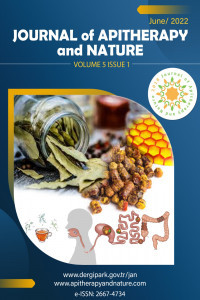Study of Relationship between Geographical Location of Collection, Chemical Composition and Biological Activity of Propolis by Multivariate Data Analysis
Study of Relationship between Geographical Location of Collection, Chemical Composition and Biological Activity of Propolis by Multivariate Data Analysis
Propolis Chemical Composition, Biological Activity, DPPH, Staphylococcus aureus,
___
- .
- Yayın Aralığı: Yılda 2 Sayı
- Başlangıç: 2018
- Yayıncı: Oktay YILDIZ
Muhammad IQBAL, Tai-ping FAN, David WATSON, Sameah ALENEZI, Muhamad SAHLAN
Effects of Propolis on the Quorum Sensing of Selected Biofilm Producing Bacterial Species
K. TENNICK, S. WAFA, H. FEARNLEY, M. GOMEZ ESCALADA
The Impact of Honeybee Origin on the Quality of Propolis
Gomes da Silva CAHANGO, Soraia I. FALCÃO, Miguel VILAS-BOAS
A Collaborative Study for Performance Evaluation of Analytical Methods for Propolis. An IHC Trial
M. LOPES, A. PEREYRA, C. KUNERT, G. BECKH, H. SCHREITER, O. G. ÇELEMLI, K. SORKUN, S GEORGÉ, L. PAULO, S. GARDINI, M.t SANCHO, V. BANKOVA, T. DASTAN, C. TANANAKI, L.f. NUNES, M. VILAS-BOAS
Flavonoids Constituents of Algeria Propolis
Segueni NARIMANE, Jesus. G. DIAZ, Akkal SALAH, Rhouati SALAH
Determination of Phenolic Acids in Raw Propolis Using Near Infrared Spectroscopy
Ana María VIVAR-QUINTANA, İsabel REVILLA, María İnmaculada GONZÁLEZ-MARTÍN, Eddy Valentín BETANCES-SALCEDO
Thirteen Flavonoids from Green Propolis from Minas Gerais, Brazil, Analyzed for Six Years
M. D. FREITAS, G. A. LOPES, N. A OLIVEIRA, B. M. ALMEIDA, S. R. L. ABREU, R. C. BASQUES, N. S. BINDA, S. M. FIGUEIREDO
What We Know, and Don't Know, about the Benefits of Propolis to Honey Bee Health
Antimicrobial Effect of Commercial Propolis Extract (BEEO©)
Aslı Elif TANUGUR, Sevgi KOLAYLI, Merve KESKIN, Sengul ALPAY KARAOGLU
Quantitative and Qualitative Variations in Propolis Collection
